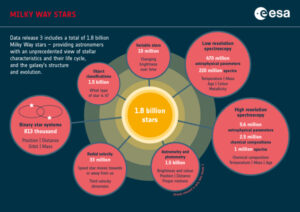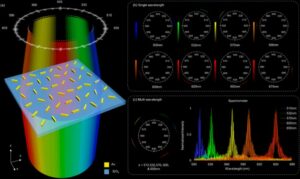Magnetic data locked in ancient crystals suggest that life may have emerged long before the Earth’s tectonic plates started moving. If the finding holds true, it would overturn the conventional notion that tectonic shifts were a pre-requisite for life, as James Dacey explains

The ground beneath our feet may appear solid and stationary. But throughout Earth’s history, the relatively thin veneer covering our planet has been repeatedly squeezed, cracked and resculpted by tectonic forces. Plate tectonics can move continents, build mountain ranges, and trigger earthquakes and volcanoes when pent up energy is suddenly released.
But while tectonics can destroy life indiscriminately at a local level, it is also vital for sustaining habitable conditions across the Earth’s surface. That’s because carbon-rich materials are recycled back into the Earth’s interior at “subduction zones” – regions where one plate is thrust under another – in a process that helps to regulate the carbon cycle. Meanwhile, water vapour and gases released through volcanic activity help to stabilize the Earth’s climate and atmospheric conditions.
We only need to look at the noxious atmosphere of Venus – with its dense carbon dioxide and sulphuric acid clouds – to see what can happen on a rocky planet without plate tectonics. That’s why many geoscientists therefore assumed that plate tectonics must have existed by the time life emerged, during the first billion years of Earth history. Plate tectonics, in essence, was considered a key pre-requisite for life.
But new findings by an international research team indicate that life could have preceded plate tectonics – and that life could have come first by some margin. If the work holds true, our young planet may have experienced a prolonged period without moveable plates, under a more rudimentary form of tectonics known as a “stagnant lid”. Such a secnario, if confirmed, would transform our understanding of how life emerges and survives – and potentially help in the search for life beyond our planet.
On shaky ground
The notion of plate tectonics may be widely accepted today, but it was controversial for many years. The story began in 1912 when the German scientist Alfred Wegener proposed the idea of “continental drift”. He suggested that today’s continents were once part of a much larger supercontinent but later drifted to their current positions on the Earth’s surface. In his book The Origin of Continents and Oceans, Wegener famously noted how the coastlines of South America and Africa fit together like a jigsaw and described how similar fossils crop up in entirely different parts of the world.
Wegener’s idea was initially met with scepticism, mainly because researchers were unsure what might have made the plates move. An answer began to emerge in the mid-20th century when a map produced in 1953 by the US geologist and cartographer Marie Tharpe revealed the existence of a mid-ocean ridge spanning the entire Atlantic Ocean and running parallel to continental coastlines. Featuring a huge valley in its centre, Tharpe argued this indicated that the ocean floor was expanding.
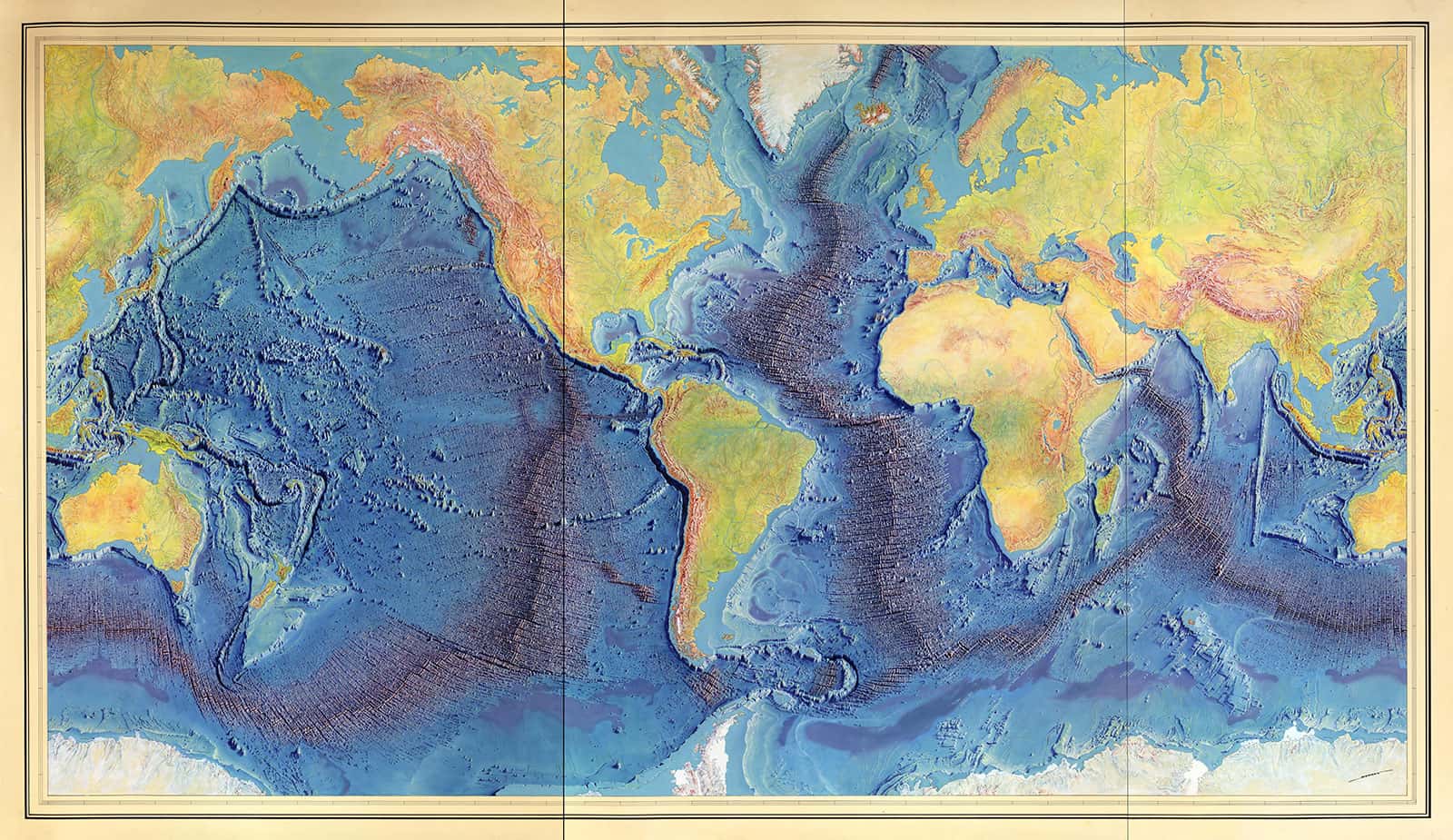
A full theory for sea-floor spreading was subsequently proposed by US geologist Harry Hess in 1962. He suggested that oceanic crust is being continuously formed at mid-ocean ridges, where molten material from the Earth’s interior wells up to the surface as part of a convection cell, before it solidifies into new ocean floor. This fresh crust is then shunted horizontally in both directions by subsequent upwelling magma.
Meanwhile, where oceanic plates border continents, older sections of oceanic crust are thrust underneath the less-dense continental crust at oceanic trenches, and recycled back into the Earth’s interior. In fact, the sinking tip of the plate also contributes to sea-floor spreading by dragging the rest of the plate behind while it plummets into the abyss.
[embedded content]
Evidence for sea-floor spreading arrived in 1963 when British geologists Frederick Vine and Drummond Matthews looked at measurements of the Earth’s magnetic field taken by a research ship travelling across a ridge in the Indian Ocean. They noticed the field was not uniform, but had anomalies that ran in stripes parallel to the ridge – and virtually symmetrically on either side of it – spanning the ocean floor. They said the stripes arise because magnetic minerals within the newly forming sea floor tend to align with the Earth’s magnetic field while the rock is solidifying. New stripes are formed each time the Earth’s magnetic field flips – a phenomenon that has occurred many times during the Earth history when the north pole suddenly becomes the south pole.
To use an analogy, the moving sea floor is rather like an old-fashioned cassette tape, recording each reversal of the geomagnetic field. Each reversal can be dated via fossil studies and radiometric testing of basalts drilled from the ocean floor, to chart a history of the magnetic field. These days, the existence of plate tectonics is now almost universally accepted.
But there is much less agreement over when plate tectonics first began. Part of the issue is that the Earth formed roughly 4.54 billion years ago and today virtually all oceanic crust older than 200 million years has been recycled back into the Earth. Our long-term archive of Earth history is, in other words, contained within hidden rock formations in the continents.
But even there, the few accessible rocks that do remain from the first billion years have been significantly altered by heat, chemistry, physical weathering and extreme pressures. That’s why no-one’s sure when plate tectonics started, with estimates ranging from more than 4 billion years ago to just 700 million years ago. It’s a huge and unsatisfactory uncertainty.
What’s more curious is that the earliest undisputed fossil evidence of life dates back 3.5–3.4 billion years, with signatures of life in sedimentary rocks indicating that life may have existed 3.95 billion years ago. So could life have emerged hundreds of millions of years before plate tectonics was even a thing? With so few original rocks surviving from this period, geologists are often stranded in the realms of speculation.
Zircons: time capsules from Earth’s fiery beginnings
Fortunately, geoscientists have a secret weapon to obtain snapshots of conditions on early Earth. Say hello to zircons – chemically stable mineral fragments (ZrSiO4) that are found in a variety of colours and geological settings. The beauty of zircons for geoscientists is that they remain largely unaffected by changes in their host rock. They’re like a time capsule of that long-distant period.
In particular, scientists have recently been studying ancient zircons that crystalized within granite rocks formed during the Earth’s first 600 million years. During this period, known as the Hadean eon, our planet was a hellish place, likely shrouded in an atmosphere rich in carbon dioxide and frequently bombarded by extraterrestrial bodies. One of them probably created the Moon.
Despite the lack of a crust, however, it appears that solid rocks must have been forming because a limited number survive today. Intact rocks as old as 4 billion years exist in the Acasta Gneiss Complex of north-west Canada, and the oldest known materials of Earth origin are 4.4 billion-year-old zircon crystals found in the Jack Hills in Australia (Nature Geoscience 10 457). They are housed in much newer, “meta-sedimentary” rocks.
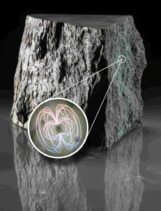
(Courtesy: University of Rochester / photo by J Adam Fenster / illustration by Michael Osadciw)
In this new research (Nature 618 531), researchers studied Jack Hills zircons spanning the period 3.9–3.3 billion years ago, as well as zircons from the same period found in the Barberton Greenstone Belt of South Africa. Led by John Tarduno from the University of Rochester in the US, the researchers were initially interested in what the zircons might reveal about the state of the Earth’s magnetic field during that period. It was only later that they realized their findings had far broader implications.
Zircon crystals from both the Australian and South African sites were found to contain inclusions of an iron-rich mineral called magnetite, which were magnetized by the Earth’s field at the time they formed. Even though billions of years have since passed, this information about Earth’s ancient magnetic field has remained locked in the zircon crystals all this time. In fact, because the Earth’s magnetic field is a dipole – with a field strength varying with latitude – measuring the strength of remnant magnetization among zircon’s magnetite content can reveal the latitude at which it formed.
The next challenge was to date the zircon samples. Conveniently, the crystal structure of zircon also incorporates uranium, which gradually decays into lead at a known rate. The researchers could therefore work out the age of the zircon crystal from the ratio of uranium to lead, which Tarduno’s team measured using a selective high-resolution ion microprobe, or SHRIMP.
If plate tectonics had existed during the 600 million years covered in this study, then you’d expect the zircon crystals to have formed at a variety of latitudes as the plates move around. That in turn would mean that zircon crystals would have a range of magnetization strengths depending on how old they are. To their surprise, however, Tarduno and team discovered something very different.
At both the Australian and South African sites, the magnetization strength remained nearly constant between 3.9 and 3.4 billion years ago. This suggests that both sets of zircons were forming at unchanging latitudes. In other words, plate tectonics had not yet started. Part of the reason for this conclusion, explain the researchers, is that, on average, plates during the last 600 million years have moved at least 8500 km in latitude. And during this recent period, there has never been an example of two plates remaining at constant latitude simultaneously.”
In other words, plate tectonics had not yet started. The researchers conclude that the Earth likely had a more rudimentary variety of tectonics, which still included some chemical recycling and fracturing of solid rock at the Earth’s surface.
The crucial difference between today’s plate tectonics and this “stagnant lid” form of tectonics is that the latter does not include plates moving horizontally across the surface, which allows for heat to be efficiently released. Instead, Earth would have been a festering world with no continental crust, populated by isolated regions of thick oceanic crust separated by areas of upwelling magma (figure 1). “Maybe stagnant lid is an unfortunate name as people might think that nothing is going on,” says Tarduno. “But what you do have is plumes of material coming up that can heat the bottom of this primordial crust and lithosphere.”
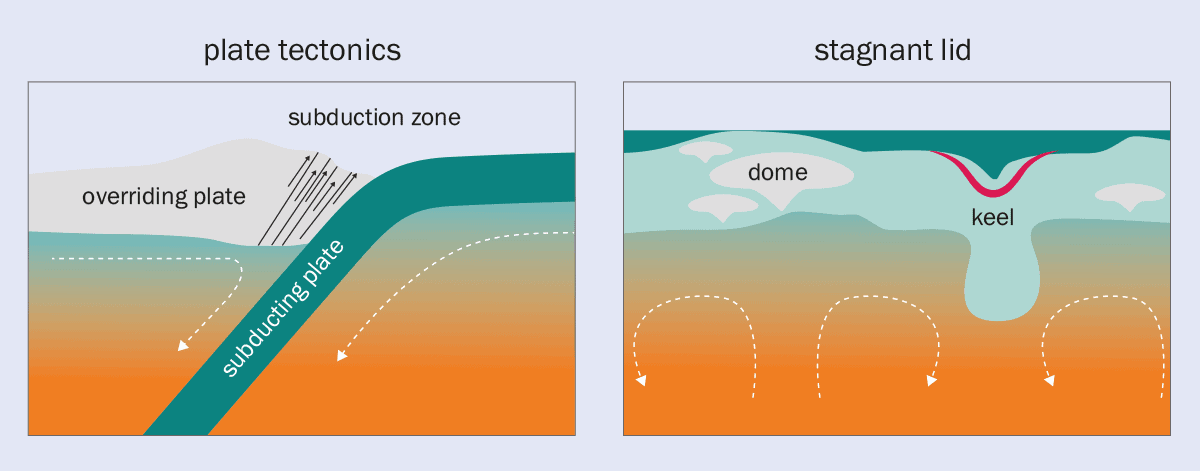
Towards the end of the study period (3.4–3.3 billion years ago), the magnetization observed in the zircon crystals starts to strengthen, which Tarduno suggests could indicate the onset of plate tectonics. The reason is that huge slabs of crust descending into Earth’s interior at subduction zones result in the mantle cooling quicker. In turn, this process can strengthen the efficiency of convection in the outer core – resulting in a stronger geomagnetic field.
A ‘Goldilocks situation’ for early life?
If basic life were already present nearly half a billion years before tectonics, as implied by this study, it raises interesting questions about how life might survive in a plate-tectonic-less world. A weaker magnetic field from this stagnant-lid phase would have left the Earth’s surface more exposed to cosmic radiation, which our current strong field shields us from. Energetic protons in the solar wind would then have collided with atmospheric particles, charging and energizing them so that they can escape into space – in principle, stripping an entire planet of its water.
But Tarduno says that even the relatively weak magnetic field strength observed in this new study would have provided some shielding. In fact, he suggests this simmering, stagnant form of tectonics may have created a “Goldilocks situation” that would have been just right for primordial life, free from the dramatic shifts in environmental conditions that can occur in fully fledged plate tectonics.
It’s a tantalizing idea because stagnant lid forms of tectonics are thought to be common throughout our solar system, existing on Venus, Mercury and in a less dynamic form on Mars.
To develop the research, Tarduno’s team now plans to study zircons of similar ages from other locations, to give a wider range of data points. “Our approach is different from previous work because we have an indicator of motion,” he says. “All arguments about plate tectonics from this time in Earth history have been based on geochemistry – not on the principal indicator of what plate tectonics is.”
Peter Cawood, an earth scientist at Monash University in Australia, who was not involved in this Nature study, says that further understanding of early Earth may come from places in our solar system whose surfaces have not been repeatedly recycled by plate tectonics. “Mars, the Moon and meteorites provide a more extensive record of their early history,” he says. “Samples from these bodies, and in particular the potential for sample-return missions from Mars, may provide important new insights into processes that acted on the early Earth.”

Epoch or event? Defining the Anthropocene
Giant leaps on that front may occur via the Mars Sample Return Mission, scheduled to launch in 2027. But Cawood reckons that perhaps a more critical question for the development of initial life is when exactly water – a prerequisite for life – first appeared on Earth. “Previous work on the Jack Hills zircons, using oxygen isotopes, suggests that there has been water since at least 4400 million years ago,” he says.
For Cawood, this research could potentially help with the search for life within our solar system and beyond – and even our concept of what life looks like. “If life on Earth developed during this stagnant lid phase, then perhaps this also occurred on Mars. If Earth had remained in a stagnant lid phase and life had continued to evolve it would certainly look different from the biosphere we have today. So, to paraphrase Spock speaking to Kirk – ‘it’s life Jim, but not as we know it’.”
- SEO Powered Content & PR Distribution. Get Amplified Today.
- PlatoData.Network Vertical Generative Ai. Empower Yourself. Access Here.
- PlatoAiStream. Web3 Intelligence. Knowledge Amplified. Access Here.
- PlatoESG. Automotive / EVs, Carbon, CleanTech, Energy, Environment, Solar, Waste Management. Access Here.
- PlatoHealth. Biotech and Clinical Trials Intelligence. Access Here.
- ChartPrime. Elevate your Trading Game with ChartPrime. Access Here.
- BlockOffsets. Modernizing Environmental Offset Ownership. Access Here.
- Source: https://physicsworld.com/a/zircons-plate-tectonics-and-the-mystery-of-life/
- :has
- :is
- :not
- :where
- $UP
- 1
- 100
- 160
- 200
- 2020
- 700
- 9
- a
- About
- AC
- accepted
- accessible
- across
- activity
- Adam
- africa
- African
- After
- age
- Ages
- ago
- Agreement
- align
- All
- allows
- alongside
- already
- also
- altered
- Although
- america
- among
- an
- Ancient
- and
- Another
- answer
- appear
- appeared
- appears
- approach
- Archive
- ARE
- areas
- argued
- arguments
- arise
- around
- AS
- assumed
- At
- Atmosphere
- atmospheric
- Australia
- Australian
- average
- back
- based
- basic
- BE
- Beauty
- because
- becomes
- been
- before
- began
- behind
- being
- beneath
- between
- Beyond
- Billion
- billions
- bodies
- book
- border
- both
- Bottom
- British
- broader
- Bruce
- build
- but
- by
- called
- CAN
- Canada
- carbon
- carbon dioxide
- centre
- Century
- certainly
- challenge
- challenging
- Changes
- charging
- Chart
- chemical
- chemistry
- click
- Climate
- come
- coming
- Common
- concept
- conclude
- conclusion
- conditions
- CONFIRMED
- Congress
- considered
- constant
- contain
- contained
- content
- continued
- continuously
- contributes
- controversial
- conventional
- Core
- could
- covered
- covering
- cracked
- created
- critical
- crop
- crucial
- Crystal
- curious
- Current
- cycle
- data
- data points
- Date
- dated
- Dates
- Days
- deep
- defining
- Depending
- described
- destroy
- develop
- developed
- Development
- diagrams
- difference
- different
- discovered
- Division
- do
- does
- dramatic
- during
- dynamic
- each
- earliest
- Early
- earth
- Earth’s interior
- efficiency
- efficiently
- either
- embedded
- emerge
- emerged
- emerges
- end
- energy
- Entire
- entirely
- environmental
- epoch
- escape
- essence
- estimates
- Even
- Event
- evidence
- evolve
- exactly
- example
- exist
- existence
- existing
- expanding
- expect
- experienced
- Explain
- exposed
- extensive
- extreme
- fact
- famously
- far
- Featuring
- Feet
- few
- field
- Figure
- finding
- findings
- First
- fit
- Flips
- Floor
- Focus
- For
- Forces
- form
- formed
- forms
- fossil
- Fossils
- found
- Free
- frequently
- fresh
- from
- front
- full
- fully
- further
- geography
- German
- Give
- Global
- going
- gradually
- greatest
- Ground
- had
- Half
- hand-painted
- happen
- Happening
- harvard
- Have
- he
- help
- helps
- Hidden
- high-resolution
- Hills
- his
- history
- holds
- Horizontal
- horizontally
- host
- How
- However
- HTML
- http
- HTTPS
- huge
- Hundreds
- hundreds of millions
- idea
- if
- image
- implications
- implied
- important
- in
- In other
- include
- included
- Indian
- indicate
- indicated
- indicates
- Indicator
- information
- initial
- initially
- insights
- instead
- interaction
- interested
- interesting
- interior
- International
- into
- involved
- isolated
- issue
- IT
- ITS
- jack
- jigsaw
- Jim
- jpg
- just
- Key
- kirk
- Know
- known
- Lack
- large
- largely
- larger
- Last
- later
- launch
- lead
- leaps
- least
- Led
- left
- less
- Level
- Library
- Life
- like
- likely
- Limited
- Lithosphere
- local
- locations
- locked
- Long
- long-term
- Look
- looked
- LOOKS
- made
- Magnetic field
- mainly
- many
- map
- Margin
- mars
- material
- materials
- max-width
- May..
- mean
- Meanwhile
- measurements
- measuring
- Mercury
- met
- Meteorites
- Michael
- might
- million
- millions
- mineral
- minerals
- missions
- Moon
- more
- motion
- Mountain
- move
- moved
- movement
- moving
- much
- must
- Mystery
- name
- Nasa
- Nature
- nearly
- Need
- never
- New
- newly
- next
- no
- North
- noted
- nothing
- Notion
- now
- number
- observatory
- obtain
- occurred
- ocean
- Ocean Floor
- of
- often
- Old
- oldest
- on
- once
- ONE
- only
- onset
- open
- or
- origin
- original
- Other
- our
- out
- over
- Oxygen
- Parallel
- part
- particular
- parts
- passed
- People
- perhaps
- period
- phase
- phenomenon
- photo
- PHP
- physical
- Physics
- Physics World
- Place
- Places
- planet
- plans
- Plate Tectonics
- plato
- Plato Data Intelligence
- PlatoData
- plummets
- points
- populated
- positions
- potential
- potentially
- present
- pressures
- previous
- Principal
- principle
- probably
- process
- processes
- Produced
- proposed
- protons
- provide
- provided
- published
- Publishing
- question
- Questions
- quicker
- raises
- range
- ranging
- Rate
- rather
- ratio
- realized
- realms
- reason
- recent
- recently
- record
- recording
- regions
- Regulate
- relatively
- released
- remain
- remained
- remaining
- REPEATEDLY
- research
- researchers
- REST
- result
- resulting
- return
- reveal
- Revealed
- Reversal
- Rich
- right
- Rock
- rocky
- roughly
- running
- Said
- same
- say
- says
- scheduled
- Scientist
- scientists
- SEA
- Search
- Secret
- sections
- see
- Sets
- settings
- shift
- Shifts
- SHIP
- show
- shrouded
- side
- Signatures
- significantly
- similar
- simultaneously
- since
- Sites
- So
- solar
- Solar system
- Solar wind
- solid
- solidifies
- solidifying
- some
- something
- South
- South Africa
- South African
- South America
- Space
- spanning
- speaking
- speculation
- Sponsored
- Spreading
- stabilize
- stable
- started
- starts
- State
- Still
- Story
- strength
- Strengthen
- strengths
- Stripes
- stripping
- strong
- stronger
- structure
- studied
- studies
- Study
- Studying
- subsequent
- Subsequently
- such
- suggest
- Suggests
- sure
- Surface
- surprise
- survive
- system
- taken
- team
- Tectonic
- Testing
- than
- that
- The
- The State
- the world
- their
- Them
- then
- theory
- There.
- therefore
- These
- they
- thing
- think
- this
- though?
- thought
- Through
- throughout
- thrust
- thumbnail
- time
- times
- tip
- to
- today
- today’s
- together
- Transform
- trigger
- true
- TURN
- two
- unaffected
- Uncertainty
- under
- understanding
- unfortunate
- universally
- university
- us
- use
- used
- using
- Valley
- variety
- Venus
- very
- via
- virtually
- vital
- Volcanoes
- was
- Water
- we
- WELL
- Wells
- were
- What
- when
- which
- while
- WHO
- whose
- why
- widely
- wider
- Wikipedia
- wind
- wisdom
- with
- within
- without
- words
- Work
- work out
- world
- would
- years
- yet
- You
- young
- youtube
- zephyrnet
- zones








